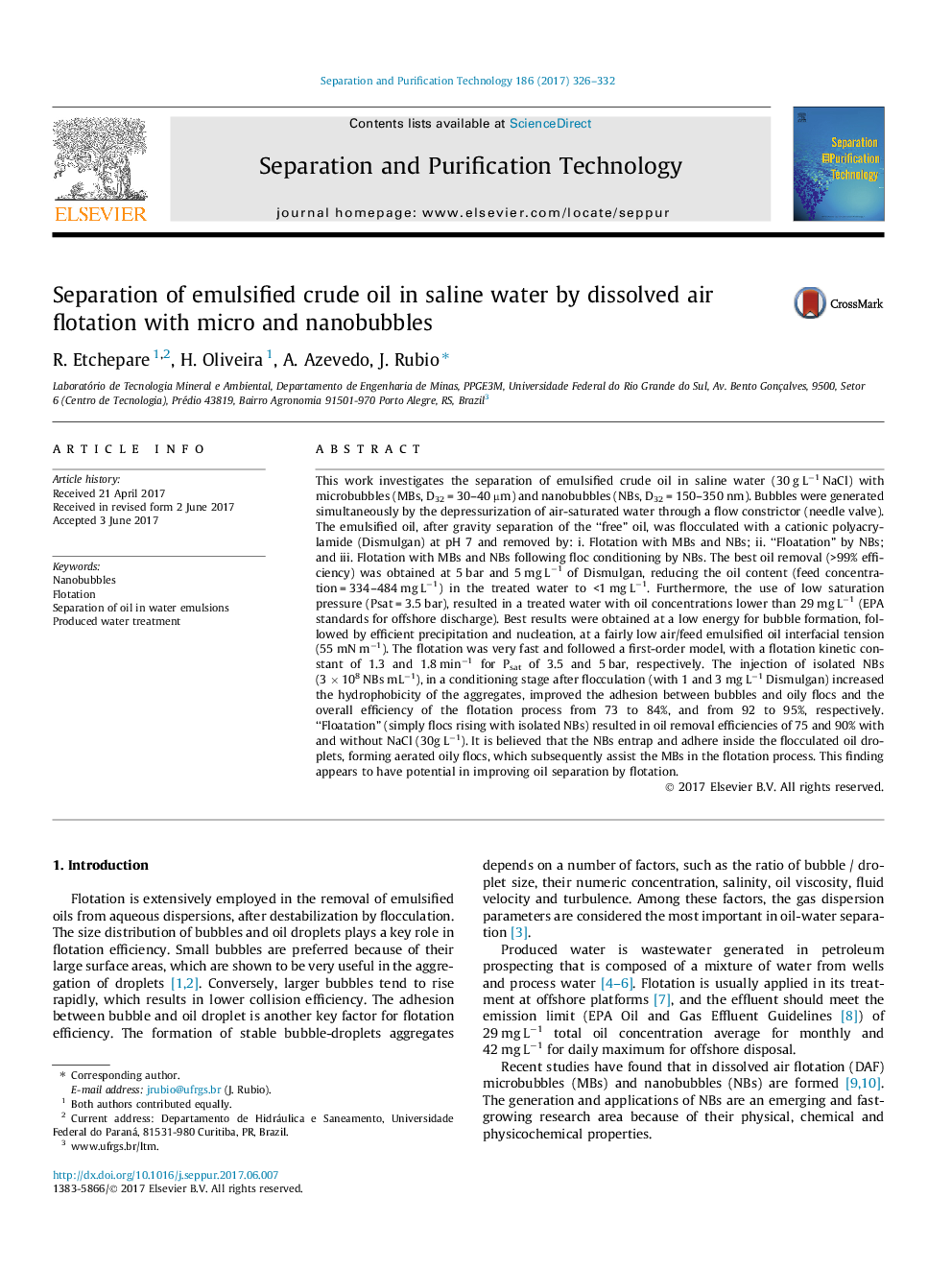| کد مقاله | کد نشریه | سال انتشار | مقاله انگلیسی | نسخه تمام متن |
|---|---|---|---|---|
| 4989906 | 1456934 | 2017 | 7 صفحه PDF | دانلود رایگان |
عنوان انگلیسی مقاله ISI
Separation of emulsified crude oil in saline water by dissolved air flotation with micro and nanobubbles
ترجمه فارسی عنوان
جداسازی روغن خام نفت امولسیون شده در آب شور با استفاده از فلوتاسیون محلول با میکرو و نانوبوبل ها
دانلود مقاله + سفارش ترجمه
دانلود مقاله ISI انگلیسی
رایگان برای ایرانیان
موضوعات مرتبط
مهندسی و علوم پایه
مهندسی شیمی
تصفیه و جداسازی
چکیده انگلیسی
This work investigates the separation of emulsified crude oil in saline water (30 g Lâ1 NaCl) with microbubbles (MBs, D32 = 30-40 µm) and nanobubbles (NBs, D32 = 150-350 nm). Bubbles were generated simultaneously by the depressurization of air-saturated water through a flow constrictor (needle valve). The emulsified oil, after gravity separation of the “free” oil, was flocculated with a cationic polyacrylamide (Dismulgan) at pH 7 and removed by: i. Flotation with MBs and NBs; ii. “Floatation” by NBs; and iii. Flotation with MBs and NBs following floc conditioning by NBs. The best oil removal (>99% efficiency) was obtained at 5 bar and 5 mg Lâ1 of Dismulgan, reducing the oil content (feed concentration = 334-484 mg Lâ1) in the treated water to <1 mg Lâ1. Furthermore, the use of low saturation pressure (Psat = 3.5 bar), resulted in a treated water with oil concentrations lower than 29 mg Lâ1 (EPA standards for offshore discharge). Best results were obtained at a low energy for bubble formation, followed by efficient precipitation and nucleation, at a fairly low air/feed emulsified oil interfacial tension (55 mN mâ1). The flotation was very fast and followed a first-order model, with a flotation kinetic constant of 1.3 and 1.8 minâ1 for Psat of 3.5 and 5 bar, respectively. The injection of isolated NBs (3 Ã 108 NBs mLâ1), in a conditioning stage after flocculation (with 1 and 3 mg Lâ1 Dismulgan) increased the hydrophobicity of the aggregates, improved the adhesion between bubbles and oily flocs and the overall efficiency of the flotation process from 73 to 84%, and from 92 to 95%, respectively. “Floatation” (simply flocs rising with isolated NBs) resulted in oil removal efficiencies of 75 and 90% with and without NaCl (30g Lâ1). It is believed that the NBs entrap and adhere inside the flocculated oil droplets, forming aerated oily flocs, which subsequently assist the MBs in the flotation process. This finding appears to have potential in improving oil separation by flotation.
ناشر
Database: Elsevier - ScienceDirect (ساینس دایرکت)
Journal: Separation and Purification Technology - Volume 186, 2 October 2017, Pages 326-332
Journal: Separation and Purification Technology - Volume 186, 2 October 2017, Pages 326-332
نویسندگان
R. Etchepare, H. Oliveira, A. Azevedo, J. Rubio,
